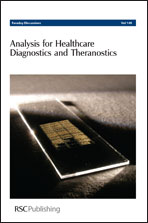In the near future, personalised medicine and phase-0 trials will require that clinical practitioners move from the “one biomarker per disease” paradigm to the use of molecular signatures of disease for diagnosis and the prediction of a patient's response to treatment. These signatures will be composed of biomarkers specific to the disease, and will include over-expression of normal protein from a gene that does not carry a mutation; loss of expression of an essential protein; expression of a protein from a mutant gene; and metabolites whose levels are altered in disease. Surrogates for protein expression, such as alterations in the messenger RNA that encode for them, have already proved their value. The next challenge, then, in clinical biosensing is to enable the multiplexed detection of protein biomarkers, and perhaps the multiplexed detection of mixed biomarkers (metabolites, RNA and proteins) all in a single test. Given the plethora of available antibodies specific for biomarkers, why is this not already happening? We believe that the limitation lies in the nature of the antibody molecule itself, and especially the fact that antibodies have evolved to function in solution, while most diagnostic tests take place at a surface. We have accordingly turned to the design of alternative antibodies, and have identified a protein that appears to be unusually stable on surfaces. The new, non-antibody, scaffold protein is derived from human Stefin A, a natural inhibitor of the cathepsin family of proteases. We have engineered this protein so that it lacks natural binding partners, and introduced a series of new binding surfaces through randomisation or directed replacement of the surfaces used by Stefin A to bind to cathepsins. Our new probes show exquisite specificity and binding affinities comparable to antibodies, and can be used to probe biology in intact cells. More importantly, together and in collaboration with other groups in Chemistry or Engineering Departments, we have shown that these designer proteins can be used in optical detection of labelled target proteins from whole cell lysates in a highly multiplexed microarray format, as well as in label-free detection of unlabelled proteins using surface plasmon resonance, QCM, microcantilevers and using electrochemical assays on gold electrodes. We believe that the combination of optimised surface chemistry, robust and combinatorial designer biological probes and novel, robust and sensitive detection technologies will enable, in the near future, the introduction of multiplexed biomarker detection in the clinical setting, most likely in cancer where multiple biomarkers are known, but probes are still lacking.

 Please wait while we load your content...
Please wait while we load your content...